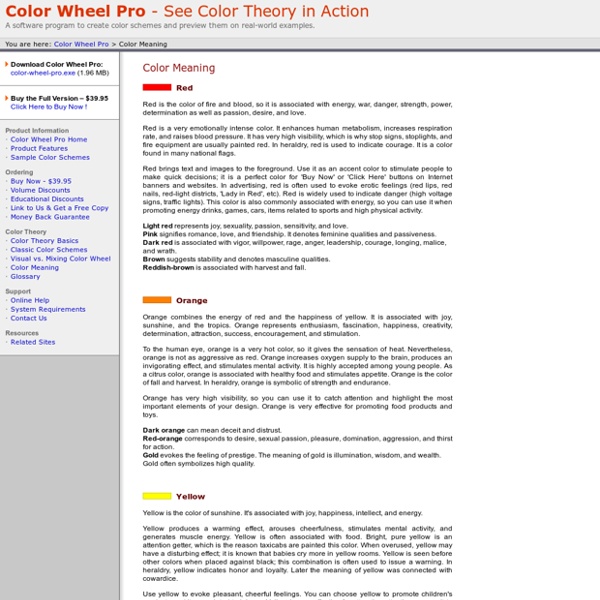Effective Use of Color Psychology in Web Design
Colors are vital elements it web designing. It can make a site look visually attractive. It is important for web designers to consider colors for it can greatly influence the site and the visitors as well.
Color Pallets
#d9e8c3 #ced181 #7c8f50
List of colors
The following is a list of colors. A number of the color swatches below are taken from domain-specific naming schemes such as X11 or HTML4. RGB values are given for each swatch because such standards are defined in terms of the sRGB color space.
Free Texture Packs To Spice Up Your Designs - Noupe Design Blog - StumbleUpon
Feb 25 2011 Every day we try our best to present to you some useful tips, dear reader, to inspire you with fresh ideas and to try out new things. Today, we’ve prepared a nice collection of free texture packs that you just may have been looking for to freshen up your designs you’re working on.
Photoshop brushes of the pros for free, skills still required
Editor’s Note (2/18/13): It’s been nearly two years since this article was published, so please be sure to check out Photoshop brushes from more amazing artists. Also if there are any broken links, please do let me know. Ah, Photoshop brushes, the enchanted tool that many young artists seek to level-up their talent. I’ve accumulated here a list of brushes used by some of the best concept artists in the industry. Some of these Photoshop brushes are provided by recognizable names such as Dan Luvisi (adonihs), Thierry Doizon (BARONTiERi), leventep, Goro Fujita, and the like — people who have worked with companies the like of Ubisoft, Eidos, 20th Century Fox, Universal, Wizards of the Coast, Marvel Comics, you get the idea. Whether you’re a seasoned digital art knight or a mere squire, hopefully you’ll find something here that may help you out in your adventure as an artist.
Color Palette Generator
Color Palette Generator #ffeeff #ffccdd #eeaaaa dull #33aa77
How To Use Color To Enhance Your Designs
People are physically, psychologically, and socially influenced by color. Color has been found to have connections to health and it can help set the mood through which your designs are seen. Color communicates meaning and so we need to be conscious of what meaning we’re conveying when we choose to use one color over another. It’s not enough for a designer to use a color simply because he or she likes that color. Color is a tool in the designer’s toolbox much the same as a grid or whitespace and it’s important to understand how to use that tool.
Gallery of Computation
LIVING WORKS binary.ring bit.10001 bone.piles box.fitting box.fitting.img new bubble.chamber buddhabrot city.traveler cubic.attractor deep.lorenz guts new happy.place new henon.phase henon.phase.deep new inter.aggregate new inter.momentary new invader.fractal limb.sand.stroke limb.strat limb.stroke mcp moonlight.soyuz nine.block node.garden new offspring orbitals new paths.i peter.de.jong sand.dollar sand.stroke sand.traveler new self-dividing.line stitches substrate new tree.garden.ii trema.disk trema.spike INFORMATION about the programmer about the medium ORDERING works available production qualities ordering policies CONTACT j.tarbell @ complexification.net
the w-ic-i
Art GraphicaFree drawing lessons in various mediumsAutodestruct.comDesign lectures Art Support FZD School
Color Rules of Thumb
"I just wanted to send you a quick email on behalf of some of the children I volunteer with at the Family Nature Club here in Utah. We've been reviewing some resources on the Internet for our science projects and came across your page and found it extremely helpful! As a thank you, a couple of the kids wanted to send you back another page they found about eco-friendly wall painting that they thought you might want to add to your site because it could help you and your visitors as well They've actually been using it as much as your page to complete their project and thought it would be exciting to see it up on the same page as where they got the information from your site that helped them so much.
Gradients
Linear gradients Linear gradients are gradients in their most basic form—a gradual blend between colors, following a straight line. I’m sure you knew that, so onto the more interesting stuff. Reflected gradients Reflected gradients are like their linear friends, but they repeat the gradient twice with the second repeat mirrored. This makes editing a little less tedious, provided it fits the result you’re trying to achieve.
120 Crayons
For the last 100 years or so kids have been exploring and creating worlds of color with Crayons. For a lot of us, our life long love affairs with color began with these wax sticks and a blank sheet of paper. According to a Yale University study, the scent of Crayola crayons is among the 20 most recognizable to American adults. Coffee and peanut butter are 1 and 2. Here we go down crayon color memory lane with all 120 color names and hex codes, fun facts and photos.
Color Think Tank - the psychology of color
Our personal and cultural associations affect our experience of color. Colors are seen as warm or cool mainly because of long-held (and often universal) associations. Yellow, orange and red are associated with the heat of sun and fire; blue, green and violet with the coolness of leaves, sea and the sky. Warm colors seem closer to the viewer than cool colors, but vivid cool colors can overwhelm light and subtle warm colors. Using warm colors for foreground and cool colors for background enhances the perception of depth.



